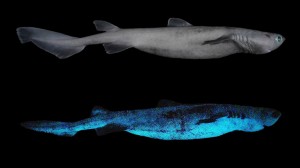Glow-in-the-Dark Shark
Wednesday, March 10th, 2021
Two views of Dalatias licha, or the kitefin shark, during daylight, top, and its luminescent pattern, bottom.
Credit: © Jerome Mallefet, National Fund for Scientific Research/Catholic University of Louvain
What’s more awesome than a shark the size of a human adult? A shark the size of a human adult that also glows in the dark!
Scientists exploring the waters off the coast of New Zealand have discovered the largest glow-in-the-dark shark, the kitefin shark. The kitefin shark is not only the largest light-up shark. It is also the largest of all glowing vertebrates (creatures with a backbone) on land or sea.
The ability of a living thing to give off light is called bioluminescence. It is the result of chemical processes in living tissues. A special enzyme converts chemical energy stored in the cells into light. This process does not produce any significant heat. Most luminescent animals are found in the ocean. For example, many squids are luminescent. Fireflies are a familiar land example. Certain bacteria and fungi also are luminescent.
The kitefin is not the first shark to give off light. The lantern shark is a small shark known for producing its own light from specialized organs called photophores. These organs cover the bottom surface of the body. The light serves as a kind of camouflage (disguise), allowing the lantern shark to blend in with light filtering through the water and hide from predators (hunting animals). The light also attracts smaller animals that the lantern shark preys upon. Photophores also line the dorsal (back) spines, producing light to ward off predators.
Sharks differ from most bioluminescent animals and plants, however, because their light-producing behavior is not regulated by the nervous system. Instead, the hormone melatonin regulates their light. Did you know that you also have melatonin? But in humans, melatonin does not regulate any built-in nightlight. Instead, melatonin promotes sleepiness. Darkness stimulates the body to produce melatonin. Light blocks the production of melatonin. The hormone helps regulate the circadian rhythm, the body’s natural cycle of waking and sleeping. So, the melatonin in your body helps you drift off into a calm sleep and dream about gigantic, glow-in-the-dark sharks . . . okay, that may sound more like a nightmare.


